GERMANS UNLEASH DEADLY U-BOATS OFF U.S. COAST
Washington, D. C. • January 11, 1942
On this date in 1942 the German Kriegsmarine launched Operation Drumbeat (Unternehmen Paukenschlag, or “roll of the kettledrums”), intending to destroy U.S. coastal shipping, particularly oil shipments from the Gulf of Mexico, and disrupt the stream of troops and key resources (e.g., agricultural products, steel, and oil) crossing the Atlantic Ocean headed for Great Britain. Five German Type IX extended-range submarines—U‑66, U‑109, U‑123, U‑125, and U‑130, each capable of carrying 22 torpedoes—began patrolling off the North American coast. British codebreakers at the Royal Navy’s Operation Intelligence Center Submarine Tracking Room had learned of German Vice Admiral Karl Doenitz’s intentions through Enigma decrypts and passed them to the U.S. Navy, but the warnings were not heeded. (Enigma was the encryption/decryption device used by the German armed forces for sending and receiving coded radio messages.) In less than a month Doenitz’s initial wolf pack sank over 26 Allied ships (156,393 tons of shipping) without suffering a loss.Operation Drumbeat took full advantage of U.S. unpreparedness and resistance to accepting advice and assistance from the British, who’d been dealing with the U‑boat menace since September 1939, in order to launch a devastating campaign against Allied and neutral shipping off the east coast of North America. Drumbeat’s destructive impact far exceeded the human and material toll of the Japanese surprise attack on the U.S. Navy Pacific fleet at Pearl Harbor, Hawaii. During the 6 months German and Italian submarines were allowed to rampage virtually unchecked in North American and Gulf of Mexico waters, 397 ships and almost 5,000 men and women were killed.
The U.S. Navy began convoy operations in May 1942, and by 1944 American shipyards were producing convoy escorts in large numbers. In the meantime Great Britain lent the U.S. Navy 24 Royal Navy antisubmarine trawlers and 10 corvettes in a sort of reverse Lend-Lease, plus transferred a Royal Air Force maritime squadron to Rhode Island to shield New York Harbor during July 1942. Only on March 1, 1942, did the U.S. Navy, using depth charges dropped from a Lockheed Hudson light bomber and coastal reconnaissance aircraft, succeed in inflicting its first U‑boat casualty, U‑656, with the loss of all hands off the Canadian (Newfoundland) coast. The first U‑boat sunk by a U.S. surface ship happened a month and a half later, on the night of April 13/14, 1942, when the destroyer USS Roper, a World War I vintage 4‑stacker on antisubmarine warfare duty finished off U‑85 near Cape Hatteras, North Carolina. The American destroyer, outfitted with British Type 286 radar, had laid a spread of 11 depth charges to kill the German marauder. Three days earlier, the doomed Type VII submarine had sunk the Norwegian freighter Christen Knudsen, its third kill during a career that had begun on April 10, 1941—a year earlier almost to the day. Discovered in the flotsam of the U‑85 the next morning were a few bodies wearing civilian clothes and carrying U.S. currency and identification.
By August 1942, the German and Italian U‑boat menace to shipping in U.S. coastal waters had been contained, due less to the Allies’ sporadic success in intercepting the Kriegmarine’s encrypted high-frequency radio communications and acting on the intelligence to their advantage than to the U.S. Navy implementing coastal antisubmarine improvements. The U‑boats’ “second happy time,” as men of the Kriegsmarine called this second phase of the Battle of the Atlantic (the first had been in 1940), had ended with the loss of 9 U‑boats and a dramatic reduction in Allied and neutral shipping losses. The same effect occurred when surface and air escorts were extended to the Caribbean.
Operation Drumbeat Wrecks Havoc on North American Shipping
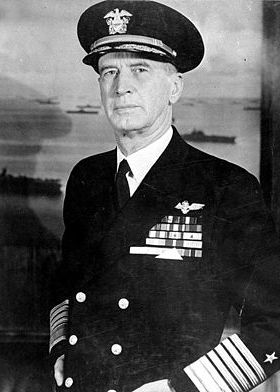 | 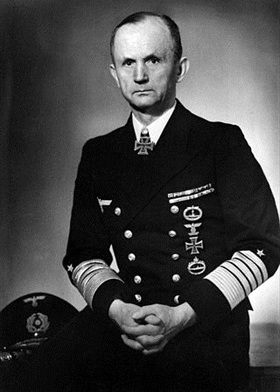 |
Left: At the start of U.S. involvement in World War II, blackouts on the U.S. eastern seaboard were not in effect, and commercial ships were not traveling in convoys. Critics of Adm. Ernest J. King (1878–1956), Chief of Naval Operations during World War II shown here in this photograph, attribute the slowness in employing these measures to his alleged Anglophobia, for the coastal escort-of-convoy operations and seaboard blackouts were British proposals. Until March 1942 King also refused the loan of British convoy escorts when the U.S. Navy had only a handful of suitable vessels. Predictably, the U.S. Navy’s delay contributed to disastrous Allied shipping losses (2 million tons in January and February 1942 alone) and the loss of many seamen and passenger lives. In King’s defense, the Navy had committed itself to transatlantic escort service, defending troop transports, and preventing the breakout of German warships from European waters by forward-deployed U.S. naval forces. Furthermore, blackouts were a politically sensitive issue and coastal cities resisted implementing them, citing the loss of tourism revenue.
![]()
Right: In October 1939 Adolf Hitler named former World War I submarine skipper Karl Doenitz Rear Admiral and “Commander of Submarines.” Less than a year later, Doenitz was made a Vice Admiral. Following Nazi Germany’s declaration of war on the United States, Doenitz planned and implemented Operation Drumbeat, which targeted shipping along the North American coast. Carried out with only 9 U‑boats beginning in January 1942, Doenitz’s wolf packs inflicted huge shipping losses with little risk. When the first Drumbeat patrols returned to occupied France in February 1942, Doenitz wrote that each commander “had such an abundance of opportunities for attack that he could not by any means utilize them all: there were times when there were up to 10 ships in sight, sailing with all lights burning on peacetime courses.” Two more U‑boat waves arrived in North American and Caribbean waters before Drumbeat played out in August 1942 for a loss of 9 U‑boats.
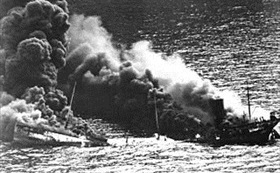 | 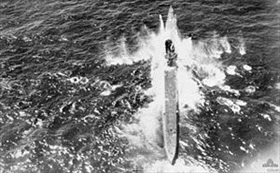 |
Left: The 8,046-ton oil tanker SS Dixie Arrow, torpedoed and sunk off Cape Hatteras, North Carolina, by U‑71 on March 26, 1942, with the loss of 11 of her 33 crewmen. The ship, en route from Texas City (near Galveston), Texas, to Baltimore, Maryland, is shown crumbling amidships as she burns furiously when her cargo of 96,000 barrels of crude oil ignited. The Drumbeat raiders focused heavily on oil tankers, which brought 95 percent of America’s Northeast oil from the Gulf of Mexico. (Northeast communities experienced oil shortages until late 1943 due to the number of tanker vessels sunk by U‑boats in early 1942.) U‑71 sank 5 ships during this patrol and returned to the safety of the huge U‑boat pens at La Pallice near La Rochelle, France, on April 20, 1942. Her skipper, Kapitaenleutnant Walter Flachsenberg, was promoted to Korvettenkapitaen on July 1, 1942.
![]()
Right: Just prior to joining wolf pack Endrass (June 12–16, 1942), which attacked a 23‑ship convoy leaving Gibraltar for Great Britain, U‑71 herself came under attack from a Sunderland flying boat patrol bomber with the Royal Australian Air Force on June 5, 1942. The Sunderland dropped 8 shallow-set depth charges and then strafed the boat repeatedly, firing 2,000 rounds of ammunition. The U‑71 managed to escape to La Pallice on the French Atlantic coast, where she was quickly repaired and sailed again on June 11 with the Endrass wolf pack. Unlike many other U‑boats, which during their service lost men due to accidents and various other causes, U‑71 apparently did not suffer any casualties. Days before the war in Europe ended she was scuttled in Wilhelmshaven, Germany, on May 2, 1945.
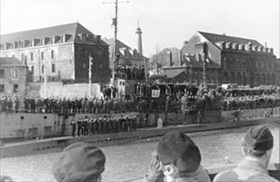 | 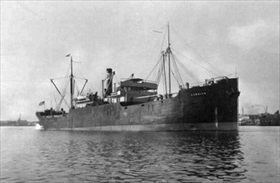 |
Left: U-123, a Type IXB U‑boat, is seen arriving in Lorient’s harbor, on the French Atlantic coast, in February 1942, following her seventh patrol. (She would make 12 patrols in all, sinking 44 ships totaling 223,367 tons and damaging 6.) The U‑123 had just completed the first phase of Operation Drumbeat. She began Drumbeat by sinking the British cargo ship Cyclops southeast of Cape Sable, Nova Scotia on January 12, 1942. Moving down the North American coast, she sank the Panamanian-flagged tanker Norness, the British-owned tanker Coimbra, 2 American-owned merchant vessels, Norvana and City of Atlanta, and the Latvian merchantman Ciltvaira. U‑123 only damaged the American tanker Malay because its skipper, 28‑year-old Richard Hardegen, had underestimated Malay’s size and chose to use his 4.1 in/10.5 cm deck gun rather than lose a valuable torpedo. Alluding to U.S. wartime unpreparedness, Hardegen (1913–2018) commented after sinking the Norvana: “These are some pretty buoys we are leaving for the Yankees in the harbor approaches as replacement for the lightships [i.e., floating lighthouses].” Surviving the war, U‑123 became the French submarine Blaison until she was decommissioned on August 18, 1959.
![]()
Right: U-123’s second Drumbeat mission was also successful—sinking Muskogee and Empire Steel on March 22 and 23, 1942, near Bermuda before moving closer to the U.S. East Coast. She then attacked the USS Atik, a Q‑ship. (Heavily armed Q‑ships masqueraded as unarmed vessels, hoping to lure U‑boats into initiating an attack, then blasting the attacker.) The disguised tramp steamer Atik, formerly the 6,610‑ton USS Carolyn, was hit on the port side; the crew started to abandon ship on the starboard side. The U‑boat moved closer, at which time the Atik revealed her concealed weaponry (among them several 4‑inch guns and .50 and .30 caliber machine guns) and opened fire on the enemy. U-123 was run off (1 submariner died in the action), but the U‑boat dived, returned, and sank her prey with a torpedo. There were no survivors from the Atik.
Operation Drumbeat: German U-Boat War Against Allied Shipping in the North Atlantic, 1942–1943
![]()

 History buffs, there is good news! The Daily Chronicles of World War II is now available as an ebook for $4.99 on Amazon.com. Containing a year’s worth of dated entries from this website, the ebook brings the story of this tumultuous era to life in a compelling, authoritative, and succinct manner. Featuring inventive navigation aids, the ebook enables readers to instantly move forward or backward by month and date to different dated entries. Simple and elegant! Click
History buffs, there is good news! The Daily Chronicles of World War II is now available as an ebook for $4.99 on Amazon.com. Containing a year’s worth of dated entries from this website, the ebook brings the story of this tumultuous era to life in a compelling, authoritative, and succinct manner. Featuring inventive navigation aids, the ebook enables readers to instantly move forward or backward by month and date to different dated entries. Simple and elegant! Click 











